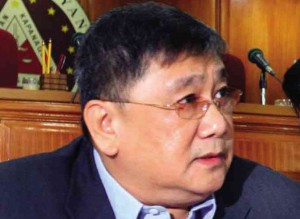MANILA, Philippines–Dismissed Sandiganbayan Justice Gregory Ong tried to influence the Supreme Court by offering to retire at a time when his fate was being decided by the high court magistrates for his alleged links with businesswoman Janet Lim-Napoles, who is alleged to be the mastermind of the P10-billion congressional pork barrel scam.
Associate Justice Marvic Leonen revealed this in his concurring opinion on the Sept. 23 high court decision dismissing Ong from the judiciary for grave misconduct, dishonesty and impropriety for “fraternizing” with Napoles, a litigant in a case that his sala handled at the antigraft court.
“Many times during the deliberations of this case, colleagues have pointed to the need for compassion for the case of Justice Ong. We are told that he has served long years as a judge and as a justice. We were even told that he attempted to informally circulate a letter through other colleagues in this court that he was willing to take optional retirement should he be meted with any kind of suspension,” Leonen said.
Offer to retire
Just before the high court released its decision on Ong’s case, there were reports that he had opted to retire. The high court said Ong never formally signified that intention. But in his concurring opinion, Leonen confirmed that Ong had indeed floated such intent, albeit informally.
“Influence peddling is wrong,” said Leonen, and called on other high court justices to “properly call out an attempt to illicitly influence this court when it happens,” saying the court has the “constitutional duty to discipline judges and justices of lower court.”
By a vote of 8 to 5, the Supreme Court dismissed Ong, finding him culpable for violating the judicial Code of Conduct and of “corrupt inclinations” for visiting Napoles in her office at least two times in 2012, fueling public “suspicion of his partiality.”
Two years earlier, the Sandiganbayan division that Ong headed had acquitted Napoles, the latter’s husband, Jimmy Napoles, and several others in a P3.8-million malversation case in connection with the delivery of substandard Kevlar helmets to the Marines in 1998.
Napoles’ former employees, Benhur Luy and Marina Sula, had testified on Ong’s links with Napoles in a Senate blue ribbon committee hearing on the pork barrel scam a year ago. The whistle-blowers said Ong had received checks amounting to P3.1 million from the businesswoman.
While the high court ruled that it would be difficult to prove the alleged bribery, the court “found credible evidence of Ong’s association with Napoles.”
Gifts, favors
But Leonen was more specific, saying “Justice Ong improperly received gifts and favors from Napoles.”
He said the antigraft magistrates must hold themselves to higher account, given the nature of the cases that they handle.
“Judges and justices cannot accept gifts, favors and accommodations,” Leonen said.
“The expectations of propriety are higher for Sandiganbayan Justices like Justice Ong. It is the Sandiganbayan that has the primary exclusive jurisdiction to hear and decide the most difficult cases involving graft and corruption,” said Leonen.
Associate Justice Arturo Brion, meanwhile, urged his fellow magistrates to rethink the rule on using hearsay evidence in administrative proceedings. Brion’s proposition was in reference to part of the ruling that noted the lack of direct evidence to prove that Ong had accepted bribes.
“To be sure, I do not recommend an outright abandonment of our rule on hearsay, but I submit that it is high time that we reexamine its strict application in administrative proceedings, particularly in disciplinary proceedings of judges and justices where bribery charges are involved,” said Brion in his 27-page concurring opinion.
Strict application
He pointed out how the “unnecessarily strict application of hearsay… has crippled this court’s capability to discipline its ranks.”
“The strict application of the hearsay rule, in effect, has shielded erring judges and justices from facing the consequences of their corrupt acts. As I earlier noted, the nature of a bribery case necessarily involves secrecy between the corruptor and the corruptee; thus, bribery rarely, if at all, surfaces when the transaction goes as planned,” Brion said.
Extreme wariness
He also noted that the court has shown its “extreme wariness in declaring that a judge had in fact been bribed, often using the hearsay rule to conclude that insufficiency of evidence prevents us from finding the judge liable for bribery.”
“It must not be lost on us that we send out a message to the public, to the members of the judiciary, and to the members of the bar, every time we decide a case involving the discipline of judges: we broadcast, by our actions, that we do not tolerate the acts for which we found the erring judge guilty. This message is lost when we penalize judges and justices for gross misconduct other than bribery, when bribery was the real root cause for the disciplinary action,” the magistrate said.
Meanwhile, Justice Secretary Leila de Lima said the Department of Justice may look into the criminal liability of Ong, if it could get its hands on the high court’s fact-finding report on which the justices based the decision dismissing Ong.
“I don’t know if that (the fact-finding report) is an attachment to the resolution of the Supreme Court, if it will be made public or if it will be shared [with us]. In any case, I’m sure the findings are in the resolution of the Supreme Court,” De Lima told reporters.
She told reporters she would have to see the exact findings of retired justice Angelina Sandoval-Gutierrez, who conducted the fact-finding investigation, from which “we can find out if there is basis for possible criminal liability. For now, I can’t say yet if there is any.”–With Jerome Aning
